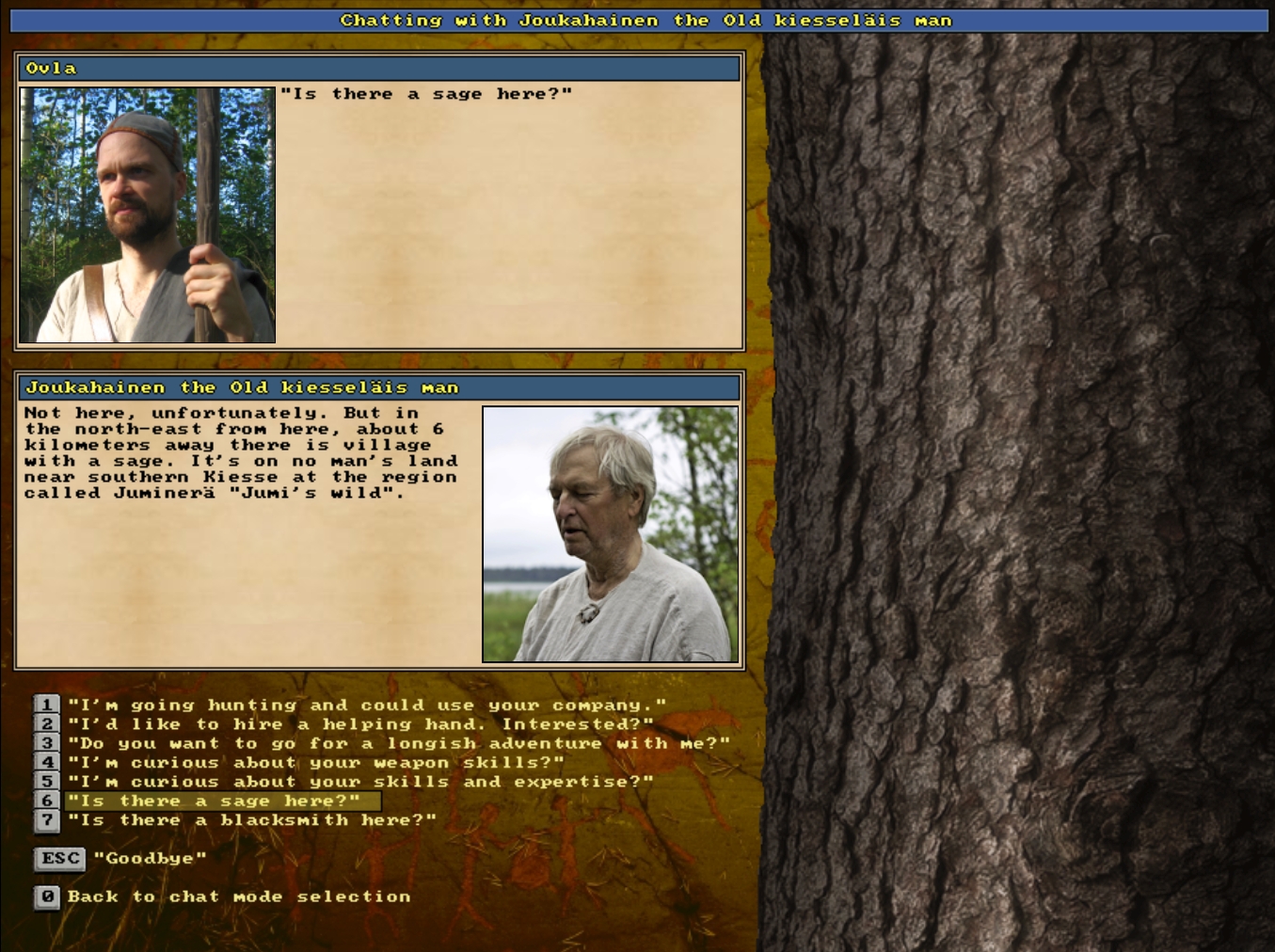See likes given/taken
| Post info | No. of Likes |
|---|---|
|
Vivi's Skill Training
Tired of repetitive spear throwing and arrow shooting? Don't want to waste resources just to upgrade your lacking carpentry? Absolutely done with button mashing for training your skills? Well fear no more! With this mod, kiss goodbye to everything above. Adds skill training to the game! Now you no longer have to waste resources/do things on repeat. Due to the way this is done, you can do multiple crafts at once; no more repetitive button mashing to train a skill! You will need to get Training Session from the Craft & Lore Training Menu in addition to the requirements listed below. They weigh 0, and each session takes 10 minutes. The max you can do in one go is 4 hours(so 24 Training Sessions at once). Installation Instructions: Just put it into the Unreal Game folder. That's it! Agriculture: Needs a shovel and any type of seeds Building: Axe and a Log Cookery: Raw Meat/Fish and Fire Herblore: Any type of Flowers Fishing: Fishing rod Hideworking: Animal Skin Timbercraft: Axe and be near a Spruce Tree Netmaking: Netting needle, Yarn and Cord(With a certain amount of foot/metre) Bowyer: Axe, Knife, Board, Bowstring Physician: Bandage Trapping: Paw-board fox trap Tracking: None Weatherlore: None Textilecraft: Fibre and a Spindle Carpentry: Axe and a Log Skiing: Skis and a Ski-stick Stealth: None Climbing: Be near a spruce tree Swimming: be at a Lake/River/Sea terrain, and be in Water tile Dodge: rock Unarmed: None Weapon training will need their respective weapons! Bow/Crossbow will need arrow. This mod adds 3 menus to your Make menu, each of which show cases the respective skills of that category. Crafting & Lore Training Menu Physical Training Menu Combat Training Menu PS: I wanted to attach images to show, but idk why the img tag isn't working... oh well. ------------ Changelog v1.1 (Updated as of URW Version 3.82, on 12th October 2023) Mod has been reuploaded, to update-just download, unzip the files in the URW Directory, and let it overwrite existing files. - Fixed Club training being overwritten by Craft Club option - Added description for Fishing training. Fishing can be trained by having a Fishing rod with any hook, or no hook at all. ------------ Changelog v1.2 (Updated as of URW Version 3.84.2, on 23rd May 2024) Mod has been uploaded as v1.2, to update-just download, unzip the files in the URW Directory, and let it overwrite existing files. - Added Netmaking skill training! - Added Bowyer skill training! ! Note that carpentry and bowyer skills have duplicate options in their own respective skill menus still. No idea why but it is ignorable. March 31, 2023, 06:02:25 PM |
1 |
|
Re: Animal droppings - an indicator and a fertilizer
I doubt that there is a chance that pesky Njerp would live long enough to suffer from a poop-infested wound or that the program will care about the Njerp long enough. Still, it is a funny idea to throw poop at your enemies, or, even better, at that unfriendly-looking huge bear 
April 01, 2023, 02:50:43 PM |
1 |
|
Re: Animal droppings - an indicator and a fertilizer
@Dmytro Ankudinov: Don't be surprised if said huge bear (or adventurer, for that matter) takes offense at your throwing crap at it though... I do agree it seems unlikely it matters if enemies get infected wounds or not, as either you or them gets killed long before that, except under unusual circumstances that aren't worth the effort to cater for. April 01, 2023, 05:20:41 PM |
1 |
Re: Animal droppings - an indicator and a fertilizer
@Dmytro Ankudinov: Don't be surprised if said huge bear (or adventurer, for that matter) takes offense at your throwing crap at it though... I’m pretty sure throwing anything at non-affiliated NPC aggroes them anyway. April 02, 2023, 09:59:31 PM |
1 |
|
Re: Be ready
Almost a year later.... Well... My very sincere congratulations on getting into NATO. Well done guys. Really. I wish we had the same chance. No matter, we will get there. April 04, 2023, 05:22:06 PM |
1 |
|
Any sages or a blacksmith in the neighborhood?
Uh oh, so I got my share of the covid which brought in over a week long hiatus to the well proceeding preparations for the upcoming release. I'm back in business now, and after the first few sweaty days in the development chambers I'm still convinced we'll see the release of 3.80 (beta) this month. The latest additions, finished today, are something to highlight; If you are looking for a sage or a blacksmith in a village, and there is none, the villagers can now tell you about these possible specialists in the neighbouring villages with directions how to reach the location. It's seemingly simple, but such a great feature. And the mechanics that we now created to make NPCs aware of their neighbouring tribesmen and tribeswomen in detail can be utilized in diverse ways in the future.   Stay tuned, the end of the month is near. April 22, 2023, 06:45:33 PM |
1 |
|
Re: Version 3.80 (beta) released
Maybe not bricks, but wattle and daub was surely a thing? Maybe a fence, water, some dung, and some dried nettles could make a weatherproof but not large inquisitive animal proof wall?
April 27, 2023, 10:55:20 PM |
1 |
|
Re: Version 3.80 (beta) released
Wattle and daub walls were fairly universal at different periods, including northern Europe. Many celtic cultures used then in neolithic times, the Romans used a refined version with lime and straw for temporary or less important buildings. My own house was built around 1200 near Bohemia and while the main construction is timber frame the filling is split sticks, straw and what we might call mud.
April 28, 2023, 10:21:35 AM |
1 |
|
BAC Mod Weaving yardage.
Now, for balance and sanity reasons this probably shouldn't be changed, but I happen to be a spinner and weaver IRL, and I've some thoughts on the yardage of thread used in weaving. Weavers calculate the yardage of thread based on several different factors: the length of a given piece of fabric, the width of a given piece of fabric, its sett (how many threads per inch), and lastly shrinkage factor. Shrinkage comes into play because threads are stretched to have them woven, and when you take them off the loom their elasticity shrinks back in. Normally shrinkage, depending on the fiber, is about 10% (with wool especially). There's also the header and the foot of the fabric, which is loom waste. You find especially little loom waste with the warp-weighted looms in the BAC mod, and with backstrap looms, so I'm not too concerned about this, but typical loom waste for a rigid heddle loom is about 12 to 18 inches, and loom waste for a jack, countermarch, or counterbalance loom is about 24 to 36 inches. The sett depends on how thick or thin the threads are. In general most fish yarn (cotton yarn used for warp in Scandinavian rug weaving) weaves up at about 12 ends per inch. So that's 12 threads of warp, + 12 threads of weft, for 24 threads per square inch. Multiply that by the length and width of a given piece of fabric — let's say we're weaving 2ft by 4ft sections here. That's 1152 square inches, multiplied by the threads per square inch, + 10 percent for shrinkage. That gives you 2534.4 ft of thread required, without calculating loom waste OR the amount of clothing you need for a garment. I'm honestly not sure anyone would continue spinning and weaving using BAC if you actually did change the numbers to be accurate to RL weaving, though. But it's just a little curiosity fact stuff that I happen to specialize in. June 25, 2023, 07:51:09 PM |
1 |
|
Re: BAC Mod Weaving yardage.
Moreover if you want to talk spinning — I'm actually more of a spinner than a weaver because I spend a lot of time knitting my output. I use a spinning wheel. The spinning wheel was a technology that increased the efficiency of spinning a fiber into thread by more than an order of magnitude. I can spin with a spindle, and for very specific technical tasks it's preferable. eg: spinning very delicate threads is easier on a drop spindle than on a spinning wheel. Now, on how the rhythms of spinning and weaving fit into agricultural life around the Iron Age and after, into the pre-industrial revolution: making yardage was a family affair. The retting and shearing could be done by anyone. Carding and combing were simple tasks that you could delegate to children. After that, the women and older girls would spin the thread. Spinning was often saved for a winter task — you didn't need much light to do it competently. Weaving, on the other hand, was a summer task — the kind of thing you could use the long daylight hours to do. This is because if you slip up in your weaving you can threaten the entire structural integrity of the cloth. Moreover, what people value in weaving and spinning then and now is completely different. Back before the industrial production of cloth, girls and women were trained extensively to turn out fine, delicate handspuns. I have seen a delicate piece of linen cloth dated to the antebellum era of the US that was translucent, woven as a sampler to show off a young lady's skills. Consistency and regularity were vital. Such consistency and delicacy was heavily devalued with factories turning out stuff, so nowadays consumers prefer handwovens and handspuns that reflect a slight human irregularity in the touch, or a method of spinning and plying that machines cannot replicate. So back in the era of UnReal World, a young woman who could spin fine thread and weave fine cloth would be considered extremely marriageable, because if she was swift and efficient at it, and also knew how to dye cloth appealing colors, she could put some of her spare cloth on the market because it was ULTRA-VALUABLE. As for historical dye plants: people used all kinds of dyeherbs. Woad for blue, onion skins or dyers' chamomile (Anthemis tinctoria) for yellow, madder root for red. Note that this is a very, very short list. Most of these natural dyes require a mordant, or a metal salt, to make sure the colors chemically bond to the fabric. Some of the mordants used are pretty harmless — alum, for example, is used to mordant some colors, but too much of it will leave wool and other protein fibers with a weird sticky texture. Other mordants are shit you need chemical disposal facilities to get rid of. As a contemporary fiber crafter, I use acid dyes, which bond to protein fibers effortlessly with the addition of citric acid or vinegar. A large amount of the colonization of Mexico by the Spanish was driven by a consumer craze for lightfast intense red dye, which was derived from the cochineal insect that fed on prickly pear cacti. Similarly, both indigo and cotton drove chattel slavery to a great extent (although not as great as the consumer desire for sugar.) (I know most of this stuff because my university education is on theatrical costume production — but I was already spinning and weaving before I became a costume technician, and my gateway craft was knitting.) July 02, 2023, 04:58:47 PM |
1 |


